Marion Leary, MSN, MPH, RN, FAHA, understands the positive impacts innovation can have on the future of healthcare. "My role is to create innovation, cultivate and grow innovative partnerships and prepare current faculty and staff, as well as the next generation of nurses, as innovators," said Leary, who recently assumed the role of Penn Nursing's first director of innovation. Innovation is the application of a new idea or the adoption of an existing idea in a new way. In the field of nursing science, innovation might involve developing something new or adapting an old technology, approach, system or process. It's broad and usually doesn't happen in a silo, according to Leary. The results of these and other collaborations could lead to changes in how nurses care for patients, get their training, teach others, communicate with patients and families and more.
Shining light on the nurse innovator role
Leary is meeting with partners throughout the university, including at the schools of engineering, design, medicine, the graduate school of education and others. She also is nursing's voice on the Penn Health-Tech Executive Committee, which fosters health innovation at the school. "You need interdisciplinary, multidisciplinary partners to move any innovation forward," she said. [caption id="attachment_54802" align="alignleft" width="300"] Marion Leary, RN[/caption] Leary, who previously directed Penn's innovation research for the Center for Resuscitation Science, said she and colleagues studied how to integrate virtual and augmented reality, 3D printing, social media, podcasting and more into the department's research and education efforts. "I'm still enrolling for a study for a grant that I received while I was there using an augmented reality wearable headset -- the Microsoft HoloLens," she said. "We are comparing augmented reality CPR training with standard manikin CPR training." The way innovation works is this: Researchers integrated the HoloLens into a feedback manikin. As the trainee is performing CPR, data from that feedback manikin is rendered through the HoloLens, which then projects back onto the manikin as a holographic image of the circulatory system. The trainee giving CPR can visualize the blood flow to the brain and vital organs based on the actual quality of CPR they are performing, Leary said. Augmented reality is but one exciting area in nursing innovation. Some others involve the use of big data and precision medicine.
Marion Leary, RN[/caption] Leary, who previously directed Penn's innovation research for the Center for Resuscitation Science, said she and colleagues studied how to integrate virtual and augmented reality, 3D printing, social media, podcasting and more into the department's research and education efforts. "I'm still enrolling for a study for a grant that I received while I was there using an augmented reality wearable headset -- the Microsoft HoloLens," she said. "We are comparing augmented reality CPR training with standard manikin CPR training." The way innovation works is this: Researchers integrated the HoloLens into a feedback manikin. As the trainee is performing CPR, data from that feedback manikin is rendered through the HoloLens, which then projects back onto the manikin as a holographic image of the circulatory system. The trainee giving CPR can visualize the blood flow to the brain and vital organs based on the actual quality of CPR they are performing, Leary said. Augmented reality is but one exciting area in nursing innovation. Some others involve the use of big data and precision medicine.
Eyeing the role? Here are some tips to prepare
Some innovations have made history, such as the electric light bulb, the printing press and the compass. But innovation occurs at all levels of society and in healthcare. To remain competitive, hospital systems to community clinics rely on ideas that help drive efficiency, reduce costs and improve patient care. Nurses can and should be at the forefront, according to Leary.
"Especially in the healthcare system and in the community, nurses do workarounds all the time. We just don't call it innovation, but that's what they're doing and that's what they've always done," Leary said. "Now we're just looking at making it more formalized."
The World Health Organization designated 2020 as the Year of the Nurse and Midwife, in honor of the first nurse innovator Florence Nightingale. "It'll be her 200th birthday in 2020, so you're absolutely correct that the time is now to start promoting nursing innovation," Leary said. "We're working on a number of things at Penn Nursing that will help prepare nurses. We have a grant through the Rita and Alex Hillman Foundation to create an online open-access platform for nurses who are interested in learning more about nursing innovation."
Thinking with innovative intention
Penn Nursing focuses on an innovation methodology called design thinking, which is the subject of an interdisciplinary course Leary is creating at Penn Nursing.
"Design thinking comes mostly from the field of design and it's a process -- a human-centered approach for creating solutions to problems," she said. "In the medical field and in the public health field it fits really well because the foundation of design thinking is empathy, so looking at observing a problem through the lens of the person who is experiencing the problem."
It probably doesn't hurt that Leary is a self-proclaimed geek. She was named Geek of the Year by Geekadelphia, Generocity and Technical.ly Phl, for her outstanding achievements in Philadelphia's geek community in the areas of innovation, technology and activism. But being a geek isn't necessary for the role of nurse innovator, she said.
"There are a lot of ways to go about this and it's not going to be the same for everyone. There are a lot of great books and resources on innovation and design thinking, alone. But I would say we want nurses to step up and if they have a solution to a health or healthcare problem they should try and bring it to fruition," Leary said. "That doesn't necessarily mean that you need to commercialize it. But there are programs that can help you formalize it into a solution that you can bring forward."
There are accelerator programs, including the Medicaid Innovation Accelerator Program, as well as hackathons and other ways in which nurses can bring their ideas to fruition. Northeastern University School of Nursing in Boston offers hackathons and has a director of nurse innovation and entrepreneurship. Innovation programs also are well established at many of the nation's hospitals. Becker's Healthcare listed 58 U.S. hospitals with innovation programs in 2017.
Take this course to learn more about innovation:
Unlock Your Creativity: Be an Innovator! (1 contact hr) Creativity is more than just coming up with ideas. It's the process of developing the ideas and transforming them into something useful. All of today's scientific, technological marvels started as someone's idea. Creativity is an essential component to advancing nursing practice. It includes terms such as imagination, ingenuity, resourcefulness, innovation and improvisation. Nurses have to think outside the box toward the ultimate goal of discovering new and better approaches for patient care. This continuing education module discusses the age of creativity and offers suggestions for helping nurses become more creative.






